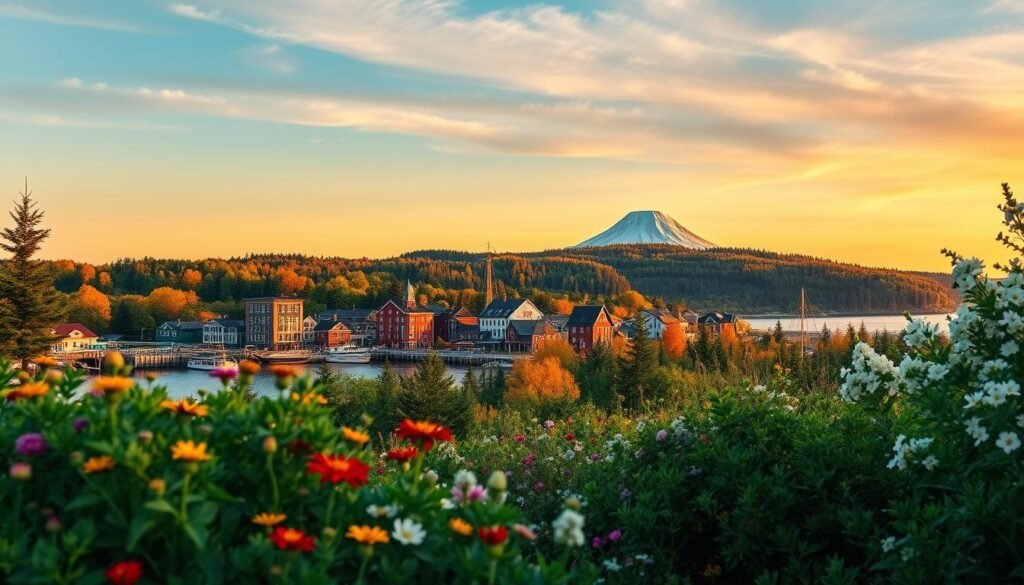Surprising fact: over half of Maine’s annual visitors arrive between June and August, making high season a real squeeze on hotels and ferries.
I plan my trips around the state’s clear seasonal rhythms so you can pick when to go with confidence. Summer brings warm days and busy coastal shops, while September often pairs mild weather with new-shell lobster and thinner crowds.
Winters feel quiet and cozy, with lower rates and fireside inns plus Maple Sunday in March. Wildlife runs are predictable: whale watching peaks June–September and puffins nest May–August, so I schedule outings around those windows.
I also note practical access—fly into Portland or Bangor, use the Downeaster from New York/Boston routes, or link through Boston by rail and bus—so you know how logistics affect your plans. For a fuller planning guide, see this roundup on seasonal highlights and booking tips from Travel + Leisure: seasonal travel guide.
Key Takeaways
- High season is June–August; book early for popular coastal towns.
- Shoulder months (May, September–October) offer milder crowds and lobster highs.
- Low season (Nov–Apr) gives better lodging deals and cozy stays.
- Whales mid-April–October; puffins May–August—plan wildlife outings around these windows.
- Portland and Bangor are main airports; Boston links by train and bus ease access.
How I Decide the Best Time to Visit Maine
I start every trip by listing what matters most—weather, crowds, and cost—then I sort dates around those priorities. Comfort and activities come first: May often hits the 60s and rarely climbs above 90°F, so days are warm enough for hikes and harbor walks without stifling heat.
I check wildlife windows and events next. Whale season runs June–September and puffins show up May–August, so I plan outings around those months. I also watch spring rain and the mid-May to mid-June black-fly window.
“If lodging rates spike, I shift by a week or choose shoulder days.”
I scan lodging calendars for rate surges and minimum stays, and I map flexibility. Fixed dates mean early hikes and museum afternoons; flexible dates let me chase better foliage or calmer seas. I layer backup options—lighthouses, museums, and coffee shops—for rainy hours.
For a deeper planning checklist, see this visit maine seasonal planning guide.
Seasons at a Glance: High, Shoulder, and Low
I break the year into three practical blocks so you can match your trip goals with what each season delivers.
Quick snapshot: summer brings the warmest days and the liveliest scene. Shoulder windows give value and fewer crowds. Low months offer quiet inns and lower rates.
High Season: June to August
What I expect: June–August is peak for beaches, boat tours, and festivals.
Book early if your times visit falls here — crowds and prices spike. Note that June can be cooler and rainier, so beaches feel less packed than July and August.
Shoulder Season: May and September–October
I favor the shoulder season for value and vibe. Days can still feel summery, and crowds thin out.
September and October are a golden window: warm late-August water, new-shell lobster in late September, and unfolding foliage that moves north to south.
Low Season: November to April
This is quiet, cozy, and budget-friendly. I use these months for fireside inns and lower rates.
Maine Maple Sunday falls on the fourth Sunday of March — a nice spring event during the low season stretch.
“Pick your season by priority — sun, foliage, or solitude — and the rest falls into place.”
| Season | Months | Highlights | Planning tip |
|---|---|---|---|
| High | June–August | Beaches, tours, festivals | Book lodging and ferries early |
| Shoulder | May; Sept–Oct | Warm days, fewer crowds, foliage | Watch ferry schedules; layer clothing |
| Low | Nov–Apr | Quiet towns, lower rates, maple events | Expect limited services; enjoy cozy inns |
For a fuller planning guide that lines up with these seasons, see this seasonal roundup.
Summer in Maine: Beach Days, Lobster Shacks, and New England Peak Vibes
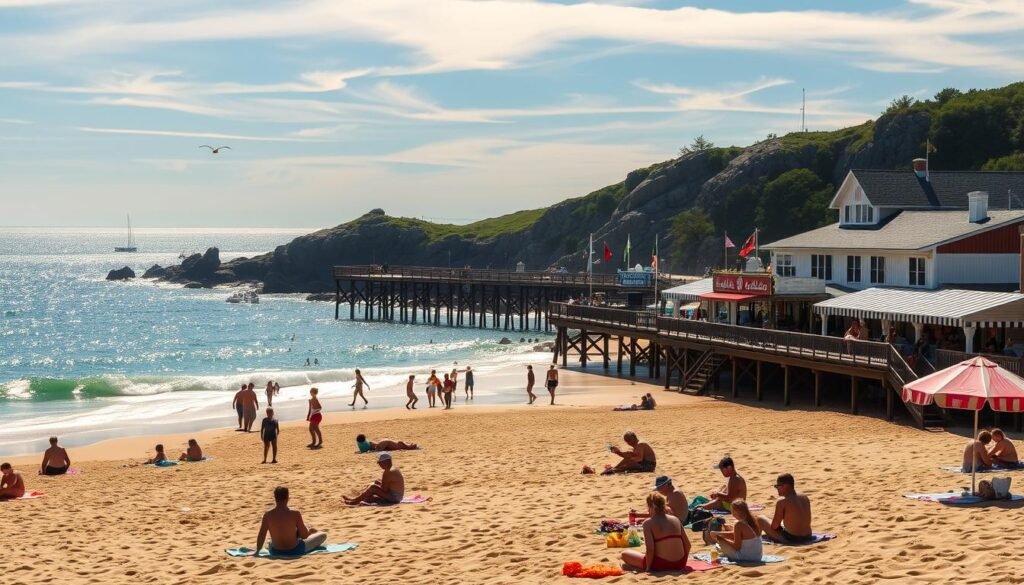
I relish summer for its long days, cool coastal nights, and the hum of harbor towns. I plan so I can enjoy sunlit hikes, calm ferry runs, and seafood without last-minute stress.
Weather and temperatures
Warm, sunny afternoons and brisk nights define the season along the coast. Temperatures rarely top 90°F, and June can still feel cool or rainy, so I pack light layers and a rain jacket.
Crowds, prices, and how far ahead I book
Summer is the peak season for lodging and ferries, so I reserve favorite inns and waterfront rooms months ahead for July and August. Late August often offers a sweet spot: warmer water, fewer families, and easier reservations.
Coastal fun: Acadia, Bar Harbor, and classic lobster rolls
I block a couple days in Acadia National Park for sunrise on Cadillac and quieter trails on Schoodic. Evenings in Bar Harbor mean harbor views and a classic lobster roll by the water.
- I plan beach hours for late morning to mid-afternoon when the coastline warms up.
- I book whale-watching during the June–September peak and aim for calm mornings.
- I keep June flexible for museums or lighthouses if weather turns.
“Late August often feels like the season’s calm encore — warm water, thinner crowds, and easier tables.”
Fall Favorites: Early Fall Warmth, Peak Foliage, and New-Shell Lobster
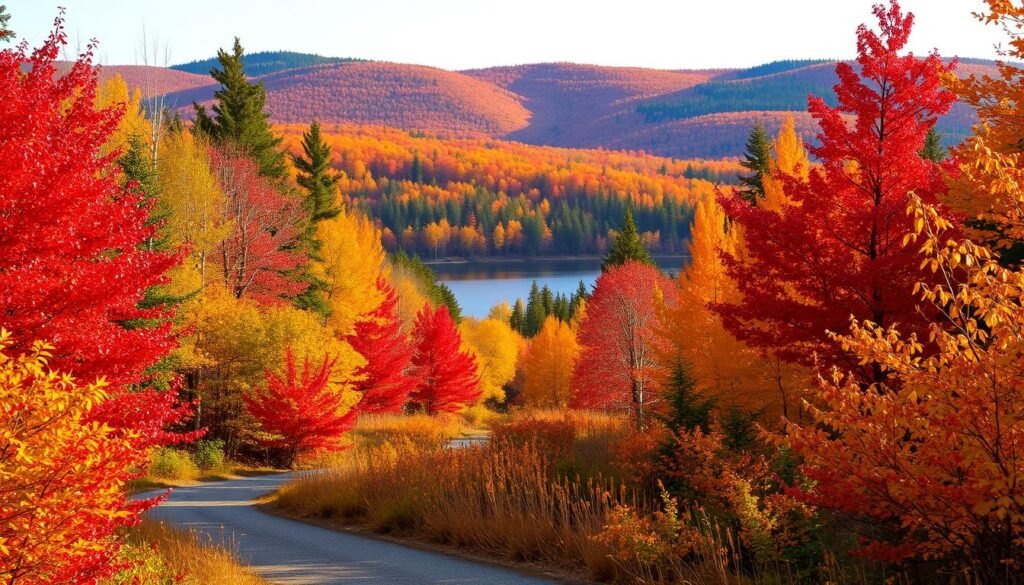
Early fall brings a clear, golden light that makes every coastal drive feel like a postcard.
I aim late September up north and the last two weeks of October around Portland for the strongest foliage bursts. Northern peaks often land in late September, while the southern coast holds color later in October.
Seafood prime time arrives in late September. New-shell lobster and maine lobster are abundant, and the Gulf of Maine yields bluefin tuna, oysters, mussels, and swordfish at top flavor.
Acadia, Bar Harbor, and whale season
I head for quieter trails in Acadia National Park and stroll Bar Harbor without summer crowds. Whale watching peaks in August and early September, so I often schedule a late-summer trip before fully shifting into leaf peeping.
“I pack a warm layer for after-dark stargazing and book restaurants only a few days ahead for easier seating.”
- I mix scenic byways with short hikes to ponds and waterfalls for mirrored foliage views.
- I add orchard stops for apple picking and cider between lighthouses and seaside overlooks.
| Period | Where | Highlights |
|---|---|---|
| Late Sept | Northern Maine | Peak foliage, new-shell lobster |
| Early–Mid Oct | Acadia / Bar Harbor | Leaf peeping, quieter trails |
| Late Oct | Portland & southern coast | Final color, restaurant ease |
Winter Wonders: Snow, Skiing, and Fireside Escapes
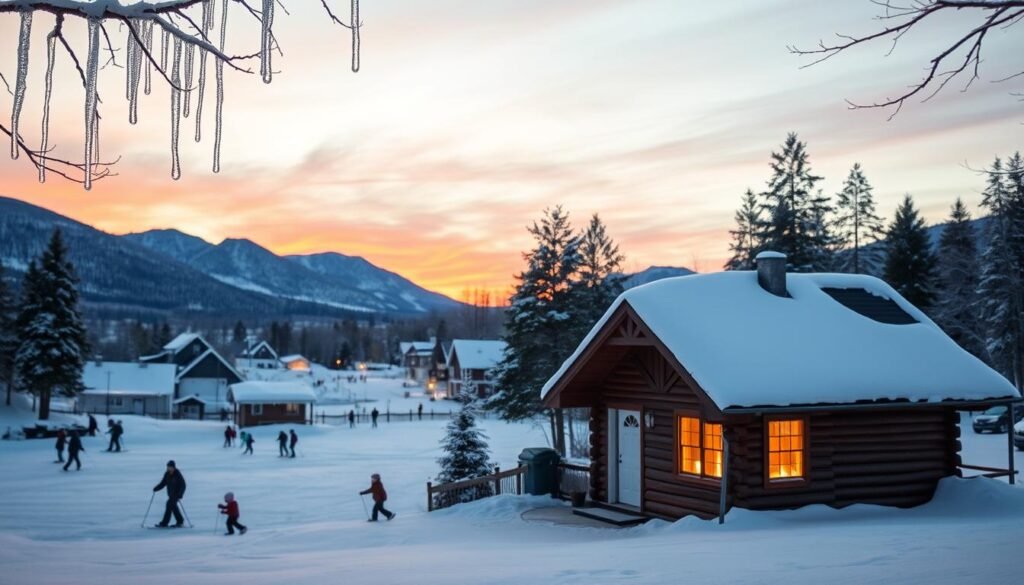
Winter reshapes the coast and mountains into a quieter, snow-dusted version of the state I know best.
Snowfall and winter sports: Sugarloaf, Sunday River, and beyond
January often delivers the deepest snow, so I plan downhill days at Sugarloaf or Sunday River around that peak. I mix alpine runs with snowshoeing, snowmobiling, and fat-tire biking to keep my plans flexible.
Cozy inns, quiet restaurants, and off-peak rates
I hunt weekday stays for lower rates and quiet inns with fireplaces. Evenings at slower restaurants feel relaxed, and the unhurried service makes cold nights feel indulgent.
Don’t miss Maine Maple Sunday in late March
I cap winter with Maine Maple Sunday on the fourth Sunday in March. Touring sugarhouses and tasting fresh syrup is a sweet reward as temperatures warm and trails begin showing spring hints.
“Hush on the trails, warm lights in village windows, and time to unwind without the summer bustle.”
- I check lift reports each night and pivot between alpine and Nordic options based on new snow.
- I leave margin for road conditions and start drives in daylight for safer travel.
Spring Trade-offs: Mud Season Magic, City Breaks, and Seaweed Week
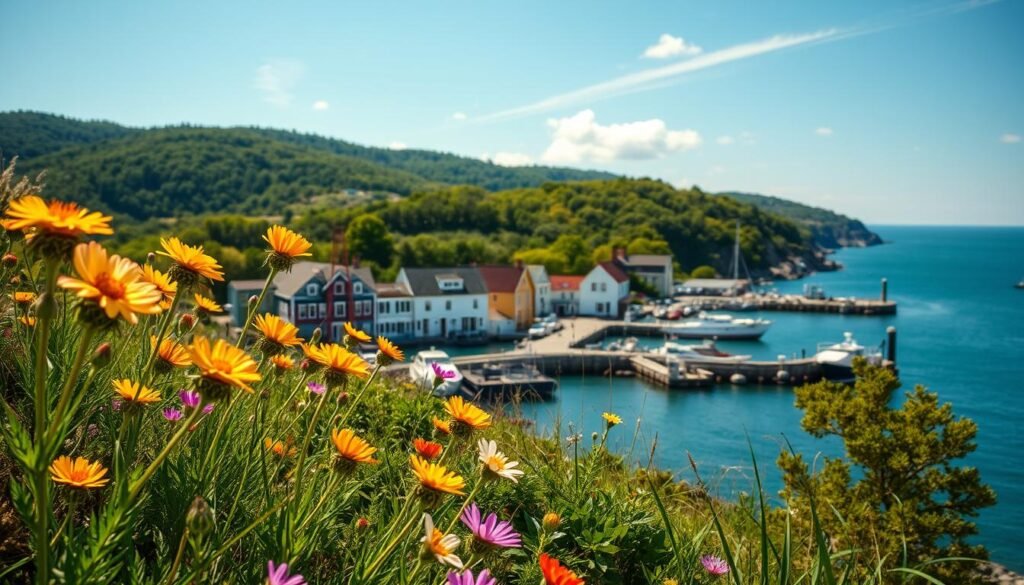
Spring can be messy and marvelous at once. I expect rainy stretches, muddy trails, and sudden sunny windows that change plans fast.
I flag mid-May through mid-June as black-fly peak. For hikers and campers, that means I favor breezy coastal walks, museum hours, and seafood markets over deep-woods outings.
Rain, mud, and practical choices
Think flexible: I book flexible hotel rates and stack indoor activities on wet days. Cities like Portland and Bangor shine now—cheaper rooms, fewer visitors, and lively coffee shops.
Seaweed Week, puffins, and late-spring skiing
I time Seaweed Week for kelp tastings and coastal events. Puffin cruises start in May and run into early summer, so I pack warm layers for the chill at sea.
Skiing often stretches into April at Sugarloaf and Sunday River. I chase a late-spring run, then trade my skis for an après scene in town.
“Spring rewards patience—slow days reveal blooms, wildlife, and quiet harbors if you plan around the mud.”
| Feature | When | How I handle it |
|---|---|---|
| Black flies | Mid-May–Mid-June | Coastal walks, museums, insect repellent |
| Seaweed Week | Spring | Kelp tastings, markets, sustainable-fishery talks |
| Late-spring skiing | March–April | Hit morning lifts, enjoy town evenings |
- I track day-by-day temperatures and keep indoor backups for heavy rain.
- I scout summer spots now—patios, ferries, and tours—so I know what to reserve later.
Best Time to Visit Maine: Month-by-Month Highlights
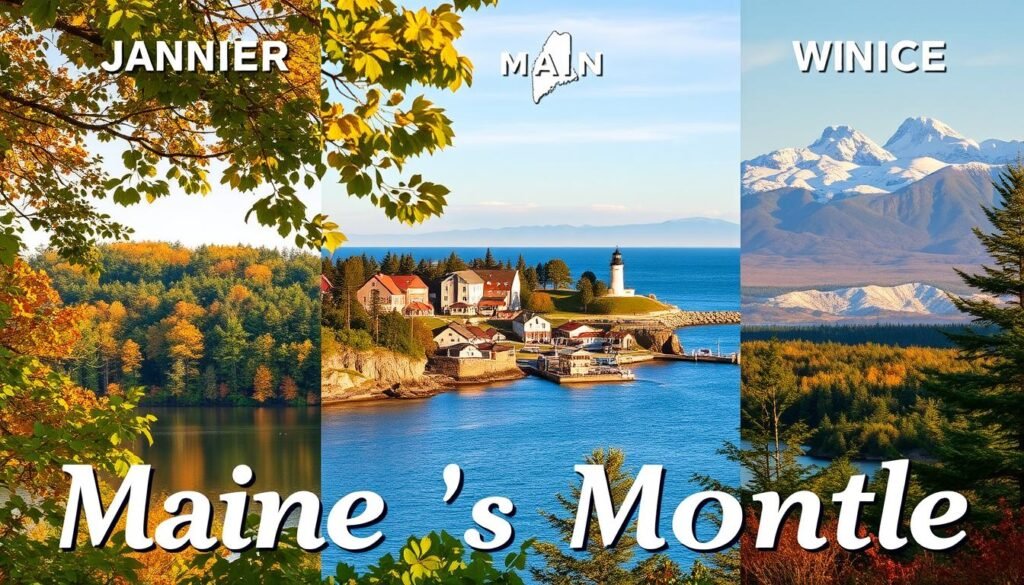
I track each month so I know where snow, lobsters, and leaf color line up with my plans throughout year.
Quick monthly guide:
- January–February: Snow lovers score quiet towns, deep snow, and strong winter-sport conditions with great hotel deals.
- March: Longer days and Maine Maple Sunday (fourth Sunday); late-season skiing still possible.
- April: A shoulder pivot—muddy trails inland but coastal walks open and whale watching starts mid-month.
- May: Warmer temperatures, puffins return, and early whale trips; pack bug spray for inland hikes.
- June: Cooler and sometimes rainy; ideal for lighthouses, ferries, and early Acadia National Park runs on the Island Explorer shuttle (seasonal).
- July–August: Full summer—long days, warm water, and peak whale watching (June–September peak).
- September: Summerlike days, fewer crowds, new-shell lobster late month, and prime national park hikes.
- October: Portland holds peak foliage in late October with glowing harbors and shoulder prices midweek.
- November–December: Quiet escapes, holiday markets, and festive coastal inns.
I use this monthly map when I pick dates, balancing weather, crowds, and activities so I get the most from my travels.
Where I Go by Region Across the Seasons
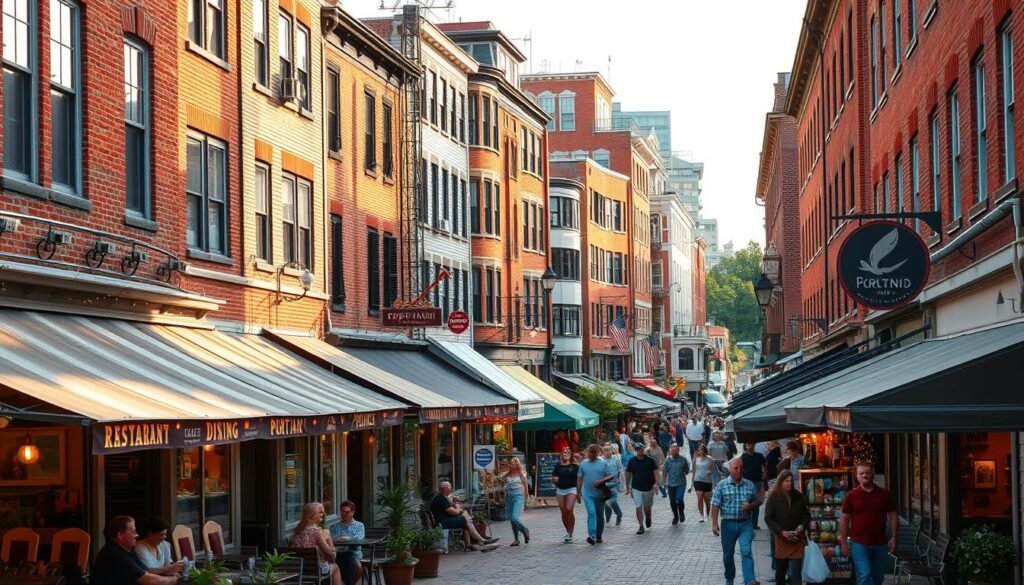
I pick a regional base and let short drives shape my daily plans across seasons. This keeps packing light and gives me options when weather shifts.
Portland and Casco Bay
I use Portland as my food-and-ferry hub. I hop Casco Bay Lines ferries for island tours and whale-watching cruises.
Evenings mean Old Port restaurants and small shops along cobbled streets.
Bar Harbor & Acadia
I spend sunsrises inside acadia national park and then drive for quieter Schoodic shoreline views of pink granite.
The Island Explorer shuttle makes midweek park runs easy in season.
Southern Coast
For sandy beaches and boardwalk vibes I head to Ogunquit and Kennebunkport. I add Rachel Carson NWR for short coastal walks.
Western Lakes & Mountains
I carve a fall loop on Rangeley Lakes Scenic Byway for peak foliage and pond paddles. Carrabassett Valley offers rolling mountain biking and historic fly-fishing heritage.
“I stack national park days midweek for easier parking, then use weekends for ferries and markets.”
| Region | Main Draw | Seasonal Focus | Practical Tip |
|---|---|---|---|
| Portland & Casco Bay | Restaurants, ferries, whale cruises | Year-round; summer island runs | Base here for food and boat access |
| Bar Harbor / Acadia | Trails, sunrise, Schoodic | Late spring–fall | Use Island Explorer; midweek for parking |
| Southern Coast | Beaches, boardwalks, NWR | Summer & shoulder season | Mix beach days with coastal reserves |
| Western Lakes & Mountains | Foliage drives, biking, fishing | Fall peak | Loop by car for best leaf color |
Activities by Season: Seafood, Beaches, Foliage, and Winter Sports
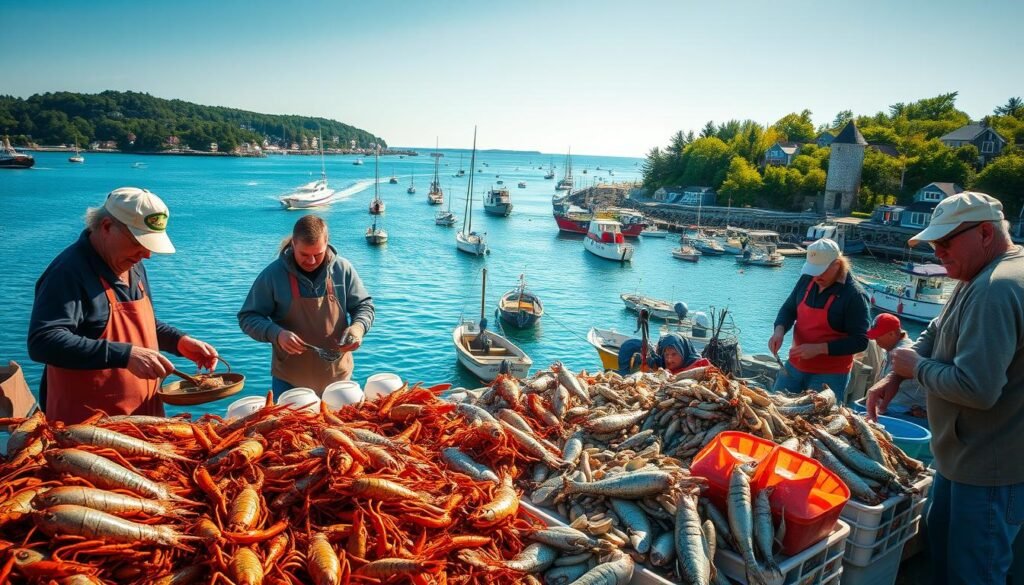
I map activities by season so each day matches weather, wildlife, and flavor.
Lobster and seafood
I plan a seafood circuit that peaks in late September for new-shell maine lobster. Fall also brings bluefin tuna, oysters, mussels, and swordfish when cool waters concentrate flavor.
I chase a classic lobster roll taste test along the coast, comparing warm-butter and mayo styles at shacks with ocean views.
Whale watching and tours
I slot a naturalist-led tour between May and October, with sightings peaking in August and early September. Combo puffin-and-whale trips run from Boothbay, and Portland wharf trips often last about four hours.
Beaches and foliage
Prime beach season is July–August, with especially pleasant water in late August into September when the shore calms down.
I weave short foliage hikes into October weekends, choosing lake-edge paths and summit loops that light up in late afternoon.
Festivals and winter sports
I pencil in events: Machias Wild Blueberry Festival for pies and music, and Seaweed Week in spring for kelp-forward menus. When snow flies, I add alpine, Nordic, snowshoeing, and fat-biking for steady outdoor winter sports.
“I measure days by energy and daylight, not miles, so each activity gets the attention it deserves.”
| Season | Top activities | Why I pick it |
|---|---|---|
| Spring | Seaweed Week, puffin trips | Fresh menus, quieter harbors |
| Summer | Beaches, festivals, whale tours | Warm days, long light |
| Fall | New-shell lobster, foliage hikes | Flavor peak and color |
| Winter | Alpine, Nordic, snowshoeing | Quiet resorts and snowy trails |
My Playbook to Beat Crowds and Save

I aim my trips at quieter windows so I get calm harbors and shorter lines without missing warm days. Small shifts in dates often cut crowds and costs while keeping the highlights intact.
Target May, early June, late August, and September–October
Why these months: insiders favor May, early June, and October for lighter crowds and good weather. Late August and September keep warm days but far fewer tourists.
How I trade a beach day for foliage or lower prices
I will swap one long beach day for a short foliage drive or a ferry hop. That trade often saves money and still feels like a full coastal experience.
Pro tip: plan a sunrise beach hour, then spend afternoon at a quieter inland outlook for color and savings.
Booking strategy for Acadia, Bar Harbor, and popular tours
I reserve Acadia lodging and Bar Harbor dinners early when my time lands in July or August. For peak weeks I keep refundable rates so I can pivot into early fall if crowds spike.
I book popular tours — like Portland whale-watching — in advance and watch forecasts, choosing the calmest day for better sightings and less seasickness.
“Stack sunrise hikes, nap mid-day, and head out for sunset while parking is easier.”
- I use shoulder season dates (May, early June, late August, Sept–Oct) to cut crowds but keep long daylight.
- I plan meals off-peak to skip lines and snag waterfront tables.
- I mix in lesser-known spots—Schoodic, Down East harbors, inland lakes—for big views with fewer people.
- I rely on Island Explorer shuttles in season to avoid Acadia parking hassles.
| Strategy | When I use it | Benefit |
|---|---|---|
| Shoulder dates | May; early June; late Aug; Sept–Oct | Fewer crowds, better rates, mild weather |
| Refundable peak bookings | July–August stays | Flexibility to shift into early fall if prices surge |
| Early tours & weather checks | Whale-watching, ferries | Better sightings, calmer seas, less chance of cancellation |
| Off-peak dining | Weekdays & early/late meals | Shorter waits, waterfront seating |
Travel Logistics: Airports, Trains, Ferries, and Getting Around
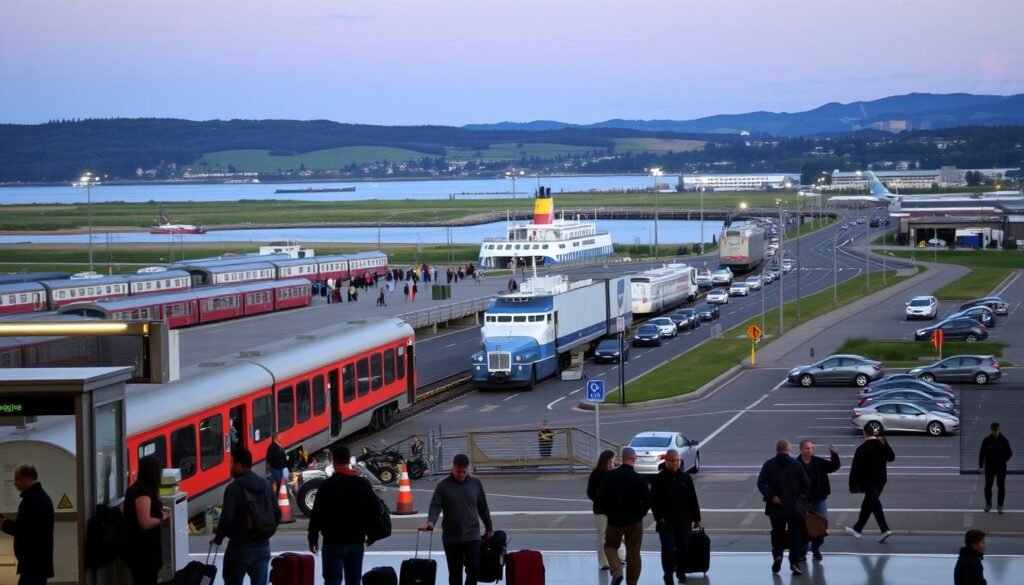
I get logistics sorted early because how you arrive shapes the whole trip. I often pick a hub, then lock in flights and ferries before filling days with tours and restaurants.
Airports and regional access
I usually fly into Portland International Jetport (PWM) for southern and MidCoast plans. Bangor International (BGR) works well when I center trips on Acadia and northern spots. For short hops into Hancock County–Bar Harbor, I route through Boston Logan.
Rail, buses, and ferries
The Amtrak Downeaster gives a relaxed, car-free start from Boston to Portland or Brunswick. Concord Coach links Boston’s stations and Logan with Portland and beyond.
Casco Bay Lines serves island day trips from Portland. The Cat runs seasonally between Bar Harbor and Yarmouth, Nova Scotia.
Driving and local transit
I drive I-95 for fast north–south mileage and use Route 1 for scenic coastal hops. In Acadia, the Island Explorer shuttle saves me parking headaches.
“Secure the big moves—flights, car, ferries—then layer tours and dining once the forecast is clear.”
| Mode | When I use it | Tip |
|---|---|---|
| Plane | PWM or BGR | Choose hub by region |
| Train / Bus | From Boston / New York | Car-free option |
| Ferry / Shuttle | Island access / Acadia | Book seasonal runs early |
Conclusion
I wrap up by saying each season hands you a different kind of Maine, and your priorities decide which one fits.
I believe there’s no single best time — there’s your best time. Pick summer for beaches and long days, or use shoulder weeks for easier plans and lower crowds.
Foliage lovers should aim late September in the north and late October around Portland. Seafood seekers chase new-shell lobster in early fall.
Winter brings snow, off-peak rates, and Maine Maple Sunday in March. Spring pairs city breaks with Seaweed Week and late-spring skiing, though watch for mud and black flies.
Whales run May–October (peak Aug–early Sept) and puffins May–Aug. Book ferries, tours, and popular inns early, mix Acadia with quieter peninsulas, and build a flexible plan that catches sun or storm alike.


